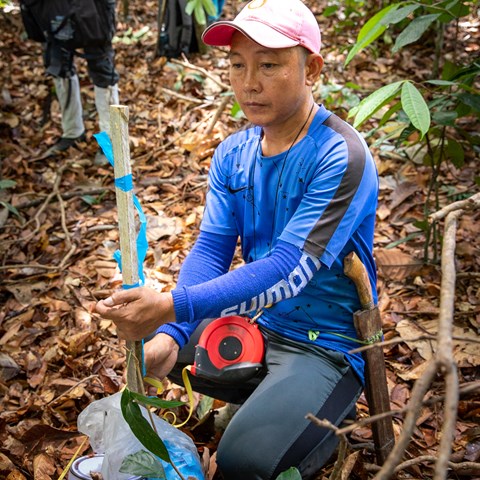Contact
Department of Forest Ecology and Management, Department of Forest Ecology and Management, joint staff

With our research, we aim to evaluate the potential of restoration and forest management of native rainforests to provide multiple values such as mitigating climate change via carbon sequestration and biodiversity, at the same time as economic benefits.
We want to communicate this novel information to scientists, practitioners, and policymakers to aid the transition to a sustainable bio-based economy.
With such large areas to restore, how can we do that most effectively? This is one of the main questions for the many restoration projects starting in the UN decade of ecosystem restoration. However, most restoration projects are evaluated only after a few years, if ever.
To address that critical gap in knowledge, we have set up large-scale replicated plots in various forest types in the 14 000 ha INIKEA restoration area. We evaluate in what situation different approaches of restoration are better;
When doing this, we also address questions such as what is the carbon storage in restored and unrestored areas of secondary forest and what is the added benefit and cost of C sequestration from restoration?
To answer this question, we are evaluating ecosystem values, such as carbon sequestration, water quality and biodiversity, and economic value in more than 50 permanent sampling plots inside the restoration area and across the surrounding landscape of large-scale oil palm and industrial tree plantations as well as undisturbed protected forests.
We use are using camera traps, soundscapes, and other novel methods for monitoring wildlife and biodiversity. We are assessing above- and below-ground carbon pools and dynamics to assess the climate mitigation potential of these different options.
Most forest restoration projects use less than five species and often use fast-growing exotic species such as Eucalyptus, Acacia, and Pine. This can be good to produce biomass and have economic benefits but is problematic for biodiversity, soil erosion, and water availability.
Therefore, many have suggested using native trees would be a better choice. However, there is hardly any knowledge of management, site requirements, and traits of indigenous rainforest trees.
Within the INIKEA restoration area, we can follow the development of more than 80 tree species that we planted. We also set up a series of common garden experiments with more than 35 native tree species, where we seek to advance the present lack of knowledge on the economic and environmental potential of indigenous species.
Here we also study the importance of species’ genetic variation for biodiversity, climate mitigation potential, and biomass production. Our three genetic common gardens are the first of this kind in which one can study the implications of within-species genetic variation for indigenous rainforest tree species.
Natural rainforests provide the highest biodiversity and ecosystem services, but conventional logging of natural forests is unsustainable and leads to degradation.
In the SUAS experiment, established in 1992, we develop silvicultural methods that make the management of natural forests environmentally and economically sustainable by implementing supervised logging (SL) techniques using directional felling, climber cutting, and planned parallel skidding trails.
The experiment consists of twenty plots, with a size of one hectare, comparing these improved harvesting methods with conventional logging and unlogged forest. The trials have since been actively monitored every second year up to 2017 and today constitute a unique dataset spanning over 25 years.
The improved methods led to less damage to standing stands and regeneration compared to the conventional and more dominant "unplanned" harvesting methods. Compared to other reduced-impact logging approaches it was less expensive and could allow more harvest without compromising recovery.
This knowledge about the dynamics of managed natural rainforests is also essential for managing the forests we restore.